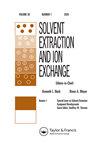四价镎离子在含有两种不同氮杂冠醚基多二乙醇酰胺配体的平板支撑液膜上的高效穿孔
IF 2.1
4区 化学
Q3 CHEMISTRY, MULTIDISCIPLINARY
引用次数: 0
摘要
摘要以硝酸为进料溶液,研究了Np(IV)在含有两种不同的氮杂冠醚基多二甘醇酰胺(DGA)配体(称为L I(3个DGA臂)或L II(4个DGA))的PTFE膜上的Pertraction。为了进行比较,还对Pu(IV)进行了一些研究。Np(IV)和Pu(IV)的萃取动力学在3 M HNO3,并在10分钟内达到与两种配体的平衡分布(D)比。然而,剥离动力学较慢,尤其是配体L II。提取和运输研究使用1.0 × 10−3M配体在95%正十二烷+5%异癸醇中的溶液。在较高的硝酸浓度下,配体L II的转运速率慢于配体L I(>1 M HNO3),并且传输速率随着两种配体的硝酸浓度而降低。使用滞后时间法估计Np(IV)的有效扩散系数(Deff)为6.2 × 10−8 cm2 s−1(L I)和4.6 × 10−8 cm2 s−1(L II)。稳定性数据表明,含有L I的支撑液膜(SLM)相对比L II更稳定,并且在配体L I的情况下,输送通量在操作9天内保持不变。本文章由计算机程序翻译,如有差异,请以英文原文为准。
Highly Efficient Pertraction of Tetravalent Neptunium Ions Across a Flat Sheet Supported Liquid Membrane Containing Two Different Aza-Crown Ether-Based Multiple Diglycolamide Ligands
ABSTRACT Pertraction of Np(IV) across a PTFE membrane containing two different aza-crown ether-based multiple diglycolamide (DGA) ligands termed as L I (3 DGA arms) or L II (4 DGA arms) was investigated using nitric acid as feed solution. A few of the studies were also carried out with Pu(IV) for comparison purposes. The kinetics of the extraction of Np(IV) and Pu(IV) was fast at 3 M HNO3 and within 10 min reaches the equilibrium distribution (D) ratio with both ligands. However, the stripping kinetics was slower especially with ligand L II . The extraction and transport studies were carried out using 1.0 × 10−3 M ligand solution in 95% n-dodecane + 5% isodecanol. The transport rates were slower with ligand L II than with L I at higher nitric acid concentrations (>1 M HNO3) and the transport rates decreased with nitric acid concentration with both ligands. The effective diffusion coefficients (D eff) of Np(IV) were estimated using the lag-time method as 6.2 × 10−8 cm2 s−1 (L I ) and 4.6 × 10−8 cm2 s−1 (L II ). The stability data suggest that the L I containing supported liquid membrane (SLM) is comparatively more stable than that of L II and the transport flux remains the same up to nine days of operation in case of ligand L I .
求助全文
通过发布文献求助,成功后即可免费获取论文全文。
去求助
来源期刊
CiteScore
4.40
自引率
5.00%
发文量
15
审稿时长
8.4 months
期刊介绍:
Solvent Extraction and Ion Exchange is an international journal that publishes original research papers, reviews, and notes that address all aspects of solvent extraction, ion exchange, and closely related methods involving, for example, liquid membranes, extraction chromatography, supercritical fluids, ionic liquids, microfluidics, and adsorption. We welcome submissions that look at: The underlying principles in solvent extraction and ion exchange; Solvent extraction and ion exchange process development; New materials or reagents, their syntheses and properties; Computational methods of molecular design and simulation; Advances in equipment, fluid dynamics, and engineering; Interfacial phenomena, kinetics, and coalescence; Spectroscopic and diffraction analysis of structure and dynamics; Host-guest chemistry, ion receptors, and molecular recognition.

 求助内容:
求助内容: 应助结果提醒方式:
应助结果提醒方式:


